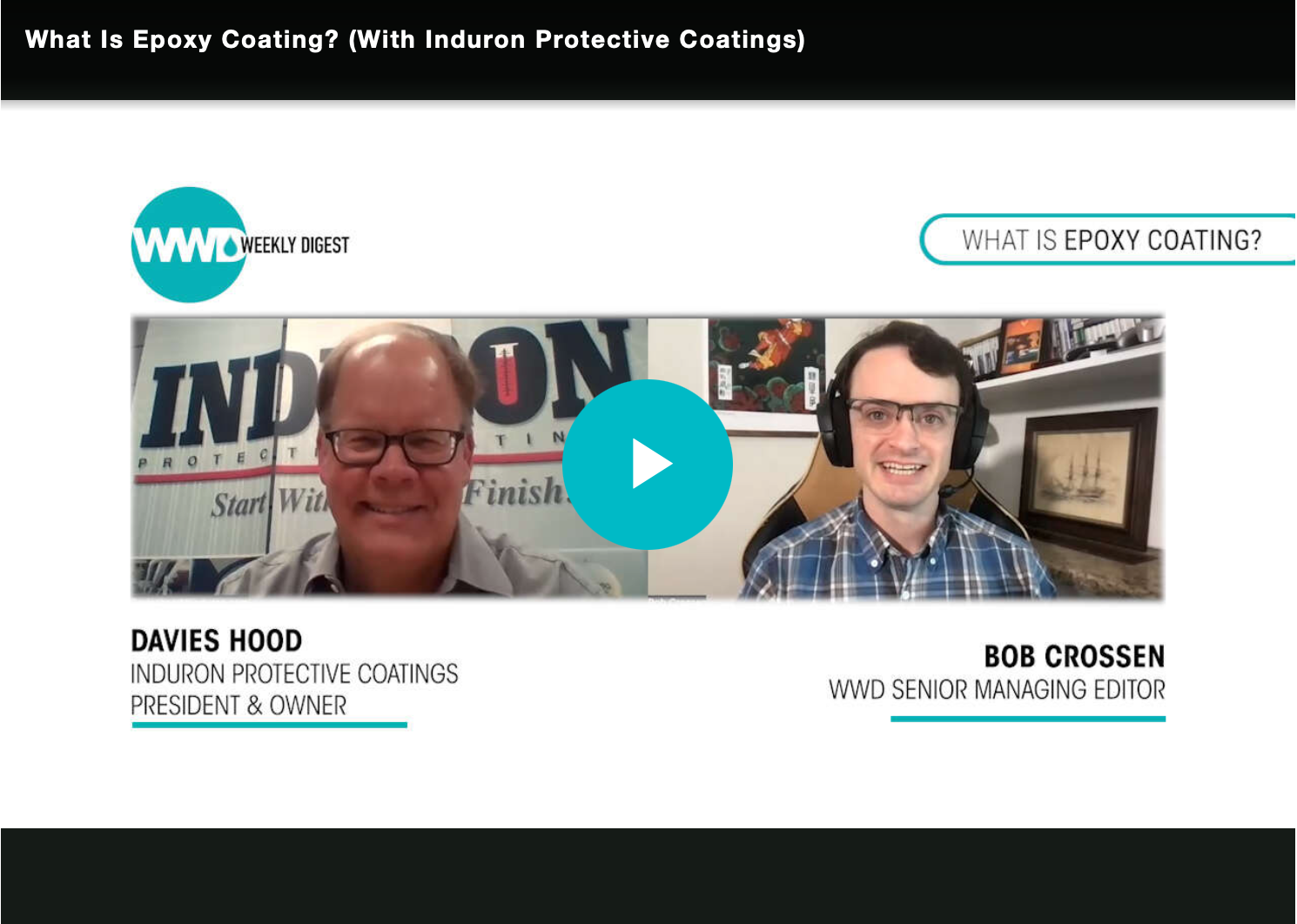 Davies Hood, President and Owner of Induron Protective Coatings, recently discussed epoxy coatings, the advantages of ceramic epoxy coatings, how they’re manufactured, what applications utilities should use them for, and how the NSF 600 regulatory changes will impact the technology in an interview with Water and Wastes Digest.
Davies Hood, President and Owner of Induron Protective Coatings, recently discussed epoxy coatings, the advantages of ceramic epoxy coatings, how they’re manufactured, what applications utilities should use them for, and how the NSF 600 regulatory changes will impact the technology in an interview with Water and Wastes Digest.
Watch the video here or read more below.
What are epoxy coatings?
Epoxy coatings are one form of protective coatings commonly used to fight corrosion. It might sound elementary, but barrier coatings protect a steel or concrete substrate from corrosive environments by providing a barrier layer between the surface and the environment that is attempting to break it down. Epoxy coatings are commonly used to protect pipe, steel and concrete water and wastewater tanks and basins used in the treatment process.
What are ceramic epoxy coatings?
At Induron, we talk about epoxy coatings a lot, specifically ceramic epoxy coatings. When we talk about ceramic epoxy, we are talking about epoxy resin that is fortified with a ceramic pigment. While the ceramic pigments that we use are only part of the pigment package, they are a very important part.
The ceramic spheres that make up part of the pigment package in our ceramic epoxies pack a lot of power to add effective layers of protection for both steel and concrete substrates.
The ceramic spheres allow us to pack more pigment into a film of paint, which results in:
- Reduced permeability.
- Increased film build.
- Prohibited microbial growth.
But, the most valuable part is that ceramic epoxies provide a surface that has better adhesion than cohesion, which means ceramic epoxies are almost self-healing! With features for microbial resistance, reduced permeability, and “self-healing,” ceramic epoxies are nothing short of phenomenal.
What’s the manufacturing process for ceramic epoxy coatings?
There are four main components of paint that are mixed together to create epoxy coatings. To keep it simple, we often compare the coatings manufacturing process to baking a cake. When manufacturing paint, we are mixing a lot of different materials together to make a chemical resistant epoxy or polyurethane coating. Like baking a cake, there are always four essential raw materials (or ingredients):
- Pigments are the solid material, such as the ceramic spheres mentioned above, used in paint manufacturing similar to how flour is used to bake a cake.
- Resin is the backbone that holds everything together in paint manufacturing, just like an egg holds everything together in baking a cake. The resins we use here at Induron are typically epoxies and polyurethanes.
- Solvents provide moisture, or the flow, that enables the paint to easily spray or roll out onto a surface, similar to adding milk to your cake mix.
- Additives are the paint colors or specialized protective elements in paint manufacturing that are similar to adding flavoring, such as chocolate or strawberry, to your cake mix.
How can utilities choose the right coating for their specific needs?
Ceramic epoxies are an ideal solution for water tanks, wastewater facilities and water treatment plants because they serve as an effective barrier coating for anything in immersion with potable water or processed water in a treatment plant.
How will regulatory changes impact ceramic epoxy technology?
Induron has manufactured ceramic epoxies for potable water storage tanks and water treatment facilities for 75 years. Coming up on Jan. 1, 2023, the industry will undergo a change as the requirements NSF/ANSI/CAN 600 are adopted into the NSF Std 61 Health Effects Evaluation and Criteria for Chemicals in Drinking Water standard.
Fortunately, Induron’s decision to go HAPs free years ago left us with a fully-compliant catalog of NSF 61/600-approved ceramic epoxy products, which already have more than a decade of proven performance. In short, NSF 600 is old news to us.
Learn more about ceramic epoxies
Contact us to learn how ceramic epoxies can work magic into your next coatings project. Read more about Induron’s ceramic epoxies on our blog:
